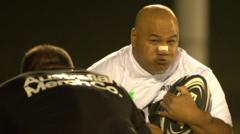As the Run It Championship League gains traction and attracts global sponsorships, its violent nature raises alarms among medical experts and community advocates, emphasizing the delicate balance between sport and safety.
Collision Sports: An Australian Phenomenon Under Fire

Collision Sports: An Australian Phenomenon Under Fire
The controversial rise of the Run It Championship League highlights both the thrill of backyard collisions and the growing concerns over safety and mental health impacts.
In the heart of Australia and New Zealand, a new collision sport known as the Run It Championship League is making waves, drawing in massive audiences and some hefty sponsorship deals. This high-octane game involves two players running at each other full tilt, with no protective gear, leading to intense clashes that have captivated sports fans. Organizers tout it as “the world's fiercest new collision sport,” while viral videos demonstrating the game’s aggressive nature have amassed millions of views online.
Originally played in backyards, especially within Pacific Islander communities, the game’s simplicity lies in its premise: one player with a ball attempts to charge straight at a defender, who must tackle without dodging or sidestepping. Following a series of successful events held in cities like Melbourne and Auckland, the league prepares to make its debut in Dubai, with a substantial prize pool of A$200,000 (approximately £98,000) on the line for competitors.
Despite its growing popularity, there is a rising chorus of caution from medical experts and the community regarding the health implications tied to the sport's violent undertones. Concerns have intensified following reports of serious injuries, including a tragic incident involving a young man who suffered fatal consequences after attempting the game at a party. Critics argue that this format promotes a toxic view of masculinity where toughness equates to worth, raising alarms about its influence on youth culture.
Founders of the league, who played the game in their youth, claim to prioritize safety with measures like medical screenings for participants and on-site health professionals at events. However, skepticism remains pervasive. Neuroscientists warn that the risk of severe brain injuries cannot be adequately mitigated through current safety protocols, emphasizing that the dangers lurk even in seemingly innocuous plays.
Adding fuel to the fire, prominent sports organizations, including Rugby Australia and New Zealand Rugby, have urged against participation in the game, labeling it as reckless. With critics advocating for the preservation of community values over profit, the future of Run It remains uncertain. As the league prepares to expand, the juxtaposition of adrenaline-driven entertainment and the potential for tragedy creates a significant dialogue about the true cost of commercializing such high-risk sports. The organizers defend their vision, suggesting that what they offer is simply an evolution of competitive sports; nonetheless, the debate on safety and ethics continues to unfold, with all eyes on how far this 'backyard game' will go on the global stage.





















